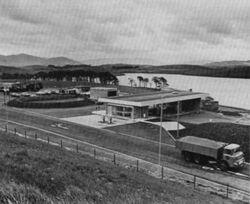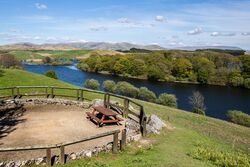History of Killington Lake services

The forecourt upon opening, with the original building just visible behind the shelter.

Planners were drawn to Killington because of its beautiful location and its ability to serve Lakeland traffic. The planned site of M6 J37 was moved north to leave enough space for the service area.
The intention was that a bridge would allow northbound traffic to access the service area, but a £350,000 price tag put paid to that idea (that's around £5million in 2025). Despite this setback, ministers insisted that something be built at Killington.
It was a favourite of engineers when they were making their site visits, and today it's still one of the country's most distinctive service areas. But it took time to get Killington Lake off the ground.
Planning
See also: M6 Service Area Planning
Instead, it was decided to reduce the size of Killington services, and to make it southbound only. Land was found nearby at Eskrigg, which would have been turned into a northbound service area once Tebay and Burton were overloaded. A secondary benefit was that splitting the project into two smaller contracts might make it easier to attract bids in what wasn't a very lucrative location.
Motorway engineers, 1967
A separate plan to extend the reservoir looked set to block the service area proposal, but eventually the two went alongside and Killington Lake gained its distinctive facility.
Killington was opened to bids as a "multi-brand, full service site with a limited capacity". Developers were required to make significant use of local materials. The initial tender process received no bids at all.
A second tender process was opened in November 1969, which only required one brand of fuel to be sold, called for "reduced scale catering", and allowed the service area to be developed in two stages, under a 21-year lease. BP were the only firm to reply, and they won the contract, calling it 'Killington Lake'. At the time BP had a joint marketing venture with Shell-Mex, who were sometimes credited as the operator. The two partnered with the brand-new Roadchef, who became responsible for running the entire site.
The service area is separated from the motorway by a man-made cutting, the land for which presumably came from the M6's construction. It was dubbed the "Britain's first hide and seek service station", because it had been deliberately landscaped to be as hidden as possible from the motorway.
The Eskrigg name continued to crop up during the 1970s and '80s, but it was a very low priority. The government ended its involvement in service area planning in 1992, with no work on Eskrigg done.
Building and Site Design
To take advantage of the views available at this location, this became one of the first sites where the amenity building was built as far away from the motorway as possible - something which is now similar to the standard practice. There was a lot of buzz around the location, which was expected to create the most beautiful service area in the country.
Howard V Lobb & Partners designed a small building which was positioned close to the forecourt (near where the hotel is today), overlooking the lake, with a walkway back to the car park. This amenity building was designed to look like "a traditional Lake District farmstead" set into the hillside, with yellow grey limestone walls and Westmorland green slate on the sloped roof. Inside, the café had large windows and was themed like a mountain hut with Alpine décor. The open entrance area had two toilets doors and a third which led straight into the dining area, where a ramp led down to the lower level. An open section was reserved for a future picnic area.
Bev Nutt, Bartlett School of Architecture, 1974
The opening documents were signed on 30 March 1972, over a year after the motorway had already opened. An opening ceremony was held on 17 May 1972, during which BP commented that the building may be too small and may have to be expanded very soon. Drawings of a possible extension were created. Parking was provided for 64 cars and 13 HGVs, and the workshop was surrounded by a grass bunker, to promote the peaceful atmosphere.
Roadchef commented in 1974 that the site was performing well despite the very low traffic levels on the motorway, and that it would have to be expanded "before long".
Egon Ronay rated the building as "poor" in his 1977 visit. He said it was pleasant to sit in, but "really very small", "painfully inadequate", "cramped", and its menu suffered from "such a lack of imagination". A 1978 government review described the services as "cheap, small and scruffy".
The plan had always been that a second phase would open in 1978. It was decided this would be built under a renegotiated tender, but plans for another southbound service area at Tebay caused the Killington expansion to be postponed. There had been talk of adding a yachting quay, but that was soon forgotten.
New Building

Eventually a new building opened in 1985, and this one was more in keeping with what had become Roadchef's usual architecture, but adapted with large windows at the back to take advantage of the view. The lobby area had Scandinavian-style wooden slats and the new Orchards restaurant area had local-style stone. It was still relatively small, with a shop at the front-left, toilets at the front-right, and a single cafeteria at the back. The old building was demolished.
The forecourt was rebuilt a few years later. It has a nod to the Lake District with dry stone walls on each side, and a shop in the middle of the road which is wrapped in stone cladding.
The service area would get very busy during the holiday season, especially with caravans. In 1986, Which? magazine describe it as "the most attractive" service area, calling it "spotless" and "relaxing". The food was still criticised. Likewise, Egon Ronay called it "pleasing" in 1990, but graded the restaurant "poor".
The hotel was built in 1994, with The Chairman of Cumbria Tourist Board, Sheila Hensman OBE, opening it at an official ceremony in July. A tourist information centre was added in 1997, housed in a converted workshop. This later closed and is now offices.
Refurbishment
Despite several rearrangements, the quiet Killington has so far escaped any major refurbishments since its reconstruction.
In March 2014, Restbite and The Burger Company were merged to create McDonald's. This and the adjacent Costa now make up the entirety of the food options at this service area.
The filling station was refurbished in summer 2018.